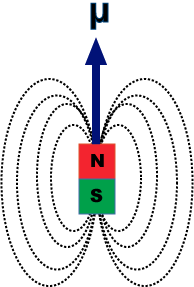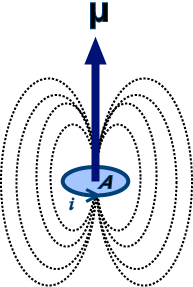The concept of the magnetic dipole is not restricted to the modeling of atomic-sized particles and can be applied to much larger objects and collections of objects. A compass needle, MR scanner, and even the earth itself might be considered giant dipoles. When the field lines of two magnetic moments cross, a dipole-dipole interaction occurs. This is an important mechanism for magnetic relaxation between two protons or between a proton and an electron in NMR about which much more will be addressed in later Q&A's.
An alternative and more quantitatively useful definition of the magnetic moment is to model it as arising from a tiny current (i) traveling around the edge of a loop of cross sectional area (A). The magnetic dipole moment (µ) is a vector defined as µ = i A whose direction is perpendicular to A and determined by the right-hand rule.
Like a compass needle, the magnetic moment (µ) will seek to align with an externally applied magnetic field (Bo). It will experience a torque (τ) or twisting force given by the vector cross product τ = µ x Bo. When perfectly aligned parallel to Bo, µ will be in its lowest energy state and experience no torque. When pointing opposite to Bo, µ will be in its highest energy state because extra energy would be required to move and maintain it in this position. For any other direction the energy (E) of the magnetic moment (µ) would be given by the vector dot product: E = − µ • Bo. The negative sign is required to account for the energy being lower when µ is aligned with Bo.
Advanced Discussion (show/hide)»
If you are a fan of CBS' The Big Bang Theory, you may remember an episode in Season 2 where Sheldon decides to spend the summer at the north pole searching for the elusive "Magnetic Monopole", hoping such a discovery would win him the Nobel Prize.
This is not fiction at all, as scientists for the last 80 years have been seeking a solitary magnetic particle that is the equivalent of a solitary electric charge. If they exist, magnetic monopoles must be extremely rare, and to date, no one has conclusively found one. But the search continues...
The interested reader may wish to check out the following links:
References
"Magnetic Moment." Wikipedia, The Free Encyclopedia.
"Magnetic Dipole." Wikipedia, The Free Encyclopedia.
Acosta D. Magnetic dipoles. PHY2061 Enriched Physics Notes, University of Florida, 2006. An excellent college-level physics set of diagrams explaining the dipole and related concepts. Even has an understandable explanation of why magnets stick together on pp 4-5 (in case you wondered).
"Magnetic Moment." Wikipedia, The Free Encyclopedia.
"Magnetic Dipole." Wikipedia, The Free Encyclopedia.
Acosta D. Magnetic dipoles. PHY2061 Enriched Physics Notes, University of Florida, 2006. An excellent college-level physics set of diagrams explaining the dipole and related concepts. Even has an understandable explanation of why magnets stick together on pp 4-5 (in case you wondered).
Related Questions
What causes magnetism?
What causes magnetism?



